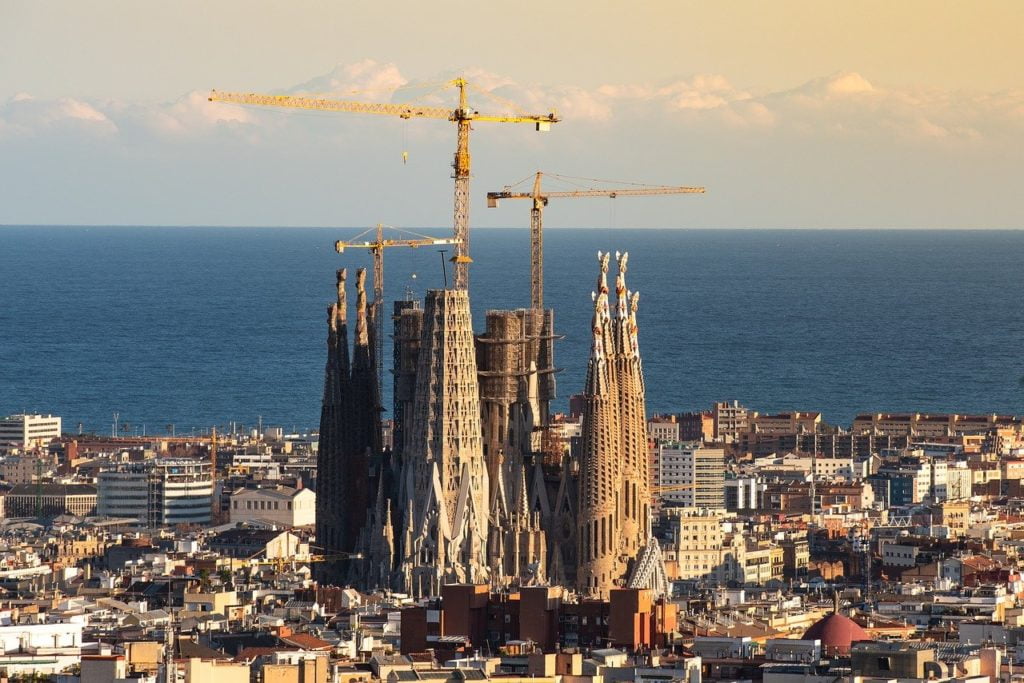Here’s How to Visit La Sagrada Familia in Barcelona
Last updated on March 27, 2023
There is something about a church that transports me through time and deposits me at an former version of myself. I step through the doors and past habits and attitudes flood my senses and course through my body. I was raised Christian and, since then, I moved onto a mixed bag of spirituality. I found it impossible these past years on the road not to identify with other cultures and religions as I met so many new people and stories and perspectives.
And although I love the temples of Asia—so much—I have talked about the vestiges of my own history that are so much more identifiable when I wander the streets of Europe. New wisdoms yield the floor to customs and traditions ingrained in me since birth. The familiarity of a church washes me in calm; I give myself permission in holy places to release life’s stresses and the hurts. It’s the act of entering the church, not the service. It’s the learned behavior that here, in this special place, you can reflect and release. Going to church was not the point of my visit, I was there for the Gaudí architecture, but the by-product of visiting the Basílica de la Sagrada Familia in Barcelona, Spain was a visit to church—no doubt an activity that made my grandmother sigh in relief. If you’re in Barcelona, this is likely at the top of your to-do list (along with reading these great books about Spain, of course, so you have historical context).
Table of Contents
Why Visit La Sagrada Familia in Barcelona
Views straight up the side of La Sagrada Familia in Barcelona, Spain, one of the most notable landmarks in a city of much beauty and history.Crowds flock to La Sagrada through a park across the street, but a few locals take time to enjoy the sunshine after stormy skies.
La Sagrada Familia is the crowning jewel of Barcelona; it’s the shining beacon of all touristy visits to the city. On my first visit, before I moved to Barcelona years later, I had just two days free in Spain’s Costa Brava.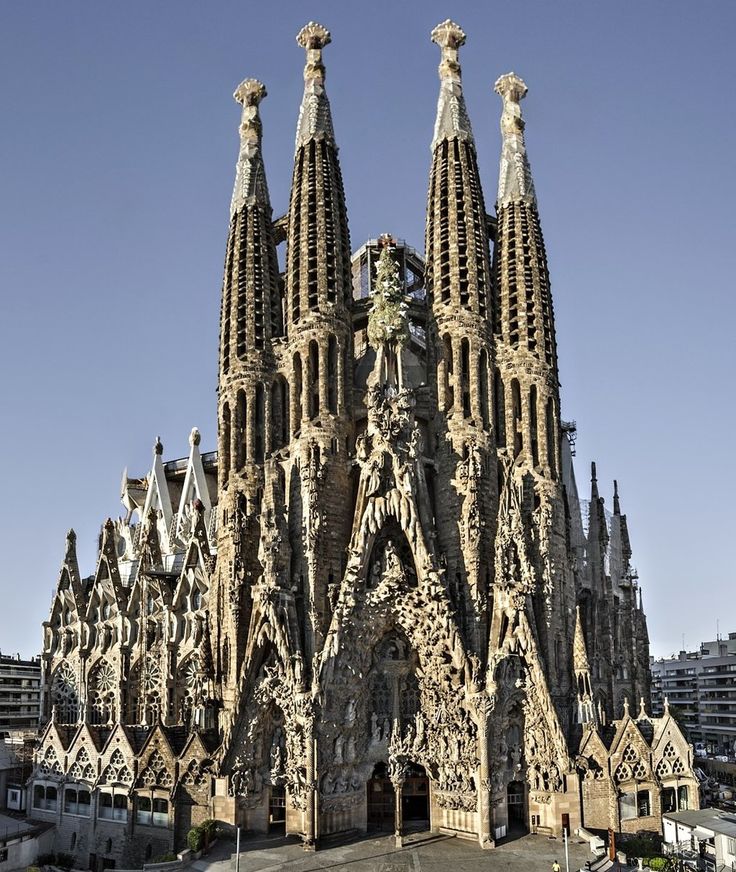
Gaudí was a Spanish architect known for his highly stylized interpretation of early 1900s Modernism. After taking a chocolate tour of the city in the morning, I started a long walk in the drizzling rain to make my late-afternoon appointment at the church (my hostel brilliantly recommended that I pre-purchase my ticket online, and you absolutely want to do the same. I make all of my guests book an appointment when they come to visit me here—more insider tips at the end). I could have used the metro and buses, but the solitude and weather matched my mood that day. Plus, Barcelona is a small city compared to many, and although it’s a long walk from the Gothic Quarter to the Sagrada Familia, it’s doable.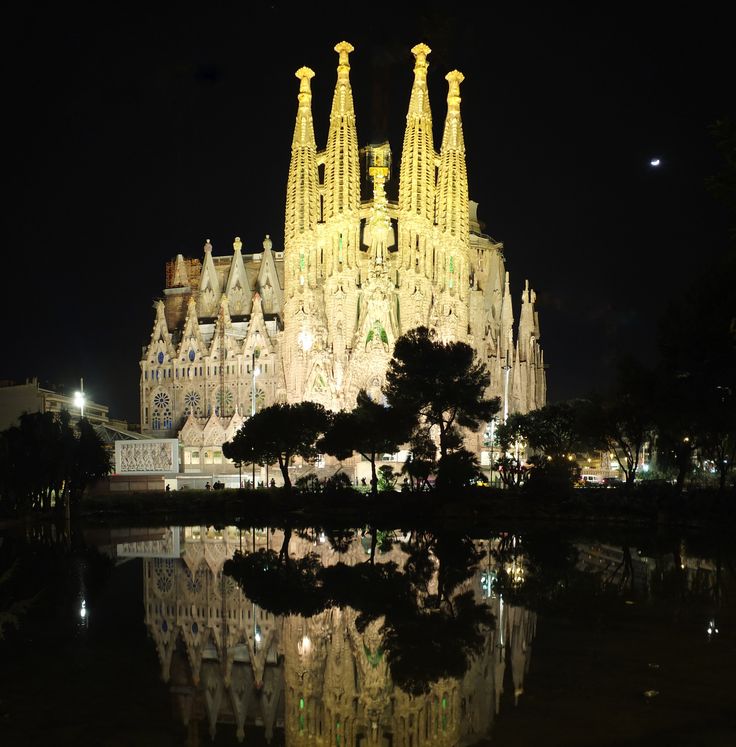
Don’t forget to book travel insurance for your trip—a great policy provides coverage in case of medical emergencies, lost or stolen gear, adventure sports riders, and more. I’ve used IMG Global for more than a decade highly recommend it!
For the first time in a year, I was back to traveling solo and my tourist map of the city had little cartoon buildings pointing my way to the church, indicating other buildings Gaudí had designed. I weaved through the wide lanes of the Eixample, lost in the pulse of city life. When I spotted a tiny nook of a café, I passed the rest of time with a hot Americano and my journal. It’s an interesting way to understand a city, to find a side-street and sit with locals. Eventually, with my time slot on the horizon, I walked toward the eight massive, intricate towers marking La Sagrada Familia (and I worried I would get lost! Not likely considering it’s the largest, hulking mass on the Barcelona skyline).
I don’t know the exact moment the church hooked me, but my fascination with the building surprised me. At times on my travels I get fatigued by sightseeing, but if there is one thing that calls to me, it’s passion. Passion and creativity are twin elements that I lament when they ebb from my own life, so as I wrapped the audio-guide around my head and absorbed myself in the story of a donation-funded church constructed over the span of decades. A church so grand in concept, design, and style that it would become the magnum opus of a century, not just a single artist.
Gaudí is but one architect on the project, but it was his passion that fueled the building of such a bizarre homage to the Gothic and Art Nouveau architecture of years past. He left intricate, detailed plans for the entire basilica that the architects who would come after him could follow—he worked on La Sagrada Familia from 1883 until his death in 1926.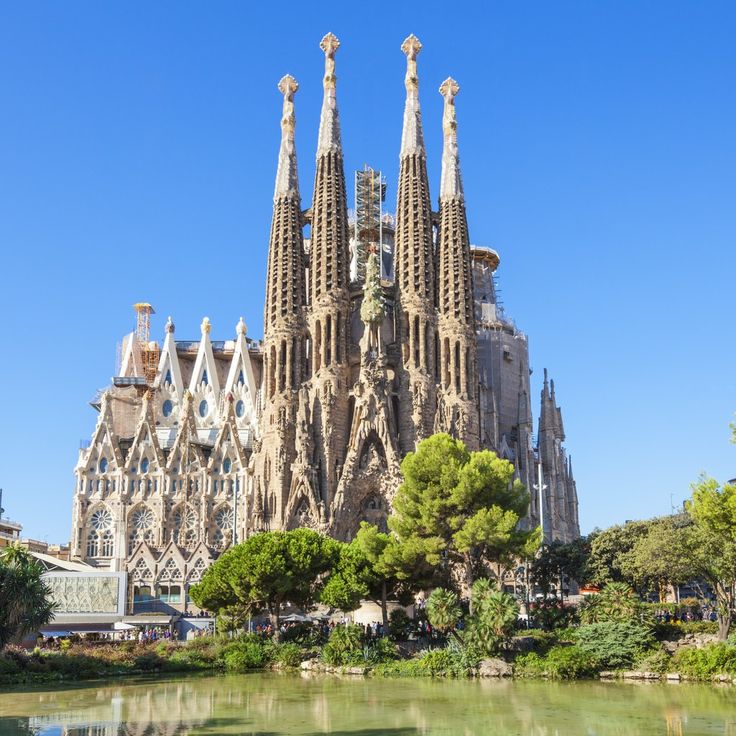
History of La Sagrada Familia
Construction of the Roman Catholic church began in 1882 and is expected to be completed in 2026, which will mark the centenary of Gaudí’s death. The Sagrada Familia is a UNESCO World Heritage Site and is one of the most visited landmarks in Spain.
Gaudí’s designs for the Sagrada Familia were innovative and unique, combining Gothic and Art Nouveau styles. He used a variety of materials in the construction of the church, including stone, iron, and ceramics. Work on the Sagrada Familia was interrupted by the outbreak of the Spanish Civil War in 1936, though Gaudí died in a tram accident in 1926, leaving the church only about a quarter completed. Work on the Sagrada Familia resumed in the 1950s and has continued to the present day, with various architects taking on the task of completing Gaudí’s vision.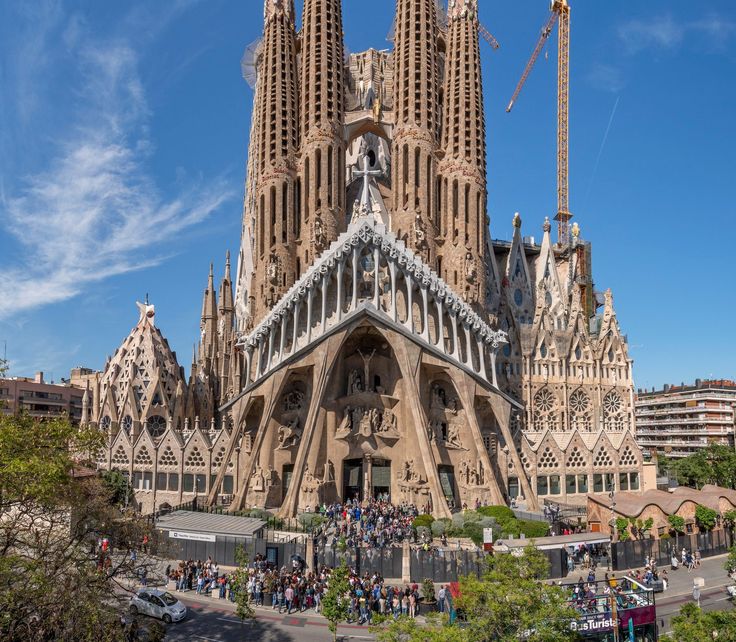
Exploring the Sagrada Familia
The Sagrada Familia has three facades dedicated to the birth, death and eternal life of Jesus. Each one is markedly different than the other.
The Nativity Façade, Designed by Gaudí
The Nativity façade of La Sagrada Familia is intricate and ornate. Flourishes and design embellishments stand in stark contrast to the sharp lines of the Passion façade.
The Nativity façade is located on the eastern side of the church and faces the city center. The Nativity Façade was designed by Antoni Gaudí, and was intended to depict the birth of Jesus Christ. It is characterized by its use of Gothic and Art Nouveau styles and is adorned with sculptures and carvings that represent scenes from the Nativity.
The Nativity Façade has four towers, each representing one of the four evangelists: Matthew, Mark, Luke, and John. It also has three porticos, each representing a different aspect of the Nativity: the Portico of the Birth, the Portico of the Angels, and the Portico of the Shepherds.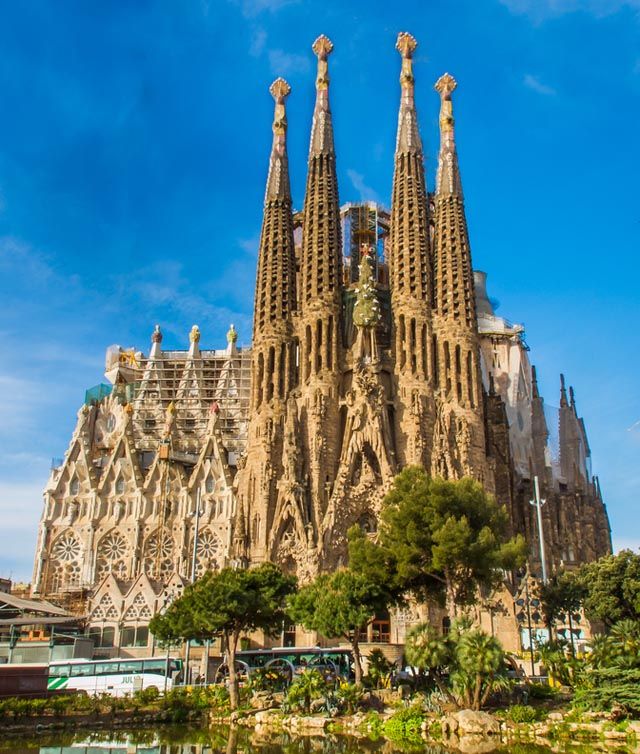
A wider view of the architecture of the Nativity façade.Gaudi designed the scenes on this façade of La Sagrada Familia.
The Passion Façade, Designed by Josep Maria Subirachs
The Passion Façade is markedly different than the Nativity façade. The style used to convey the scenes forgoes the curly flowers and ornate flourishes that make the Nativity façade so busy and visually stimulating. Instead, sharp corners and hard empty walls allow each scene on the Passion façade to jump from the building to tell its story.
The Passion Façade is one of the three main façades of the Sagrada Família in Barcelona, Spain.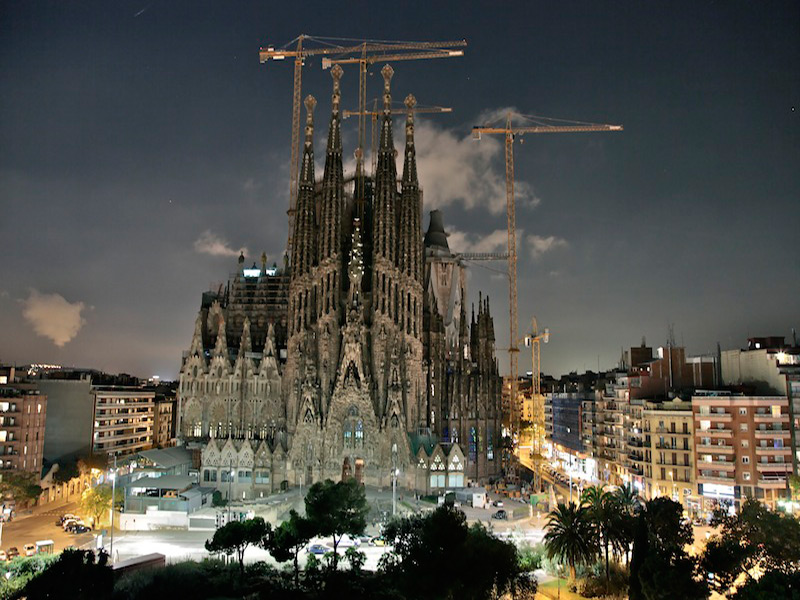
The Passion Façade was designed by Josep Maria Subirachs, and was intended to depict the Passion of Jesus Christ. It is characterized by its use of Gothic and Art Nouveau styles and is adorned with sculptures and carvings that represent scenes from the Passion.
The Passion Façade has two towers, one representing the Virgin Mary and the other representing Saint John. It also has three porticos, each representing a different aspect of the Passion: the Portico of the Virgin, the Portico of the Last Supper, and the Portico of the Ordinary. The Portico of the Virgin is decorated with sculptures of the Virgin Mary and the child Jesus, while the Portico of the Last Supper depicts the last meal that Jesus shared with his disciples. The Portico of the Ordinary is adorned with sculptures that depict the condemnation, flagellation, and crowning with thorns of Jesus. The Passion Façade is a testament to Gaudí’s artistic vision and is a popular tourist attraction in Barcelona.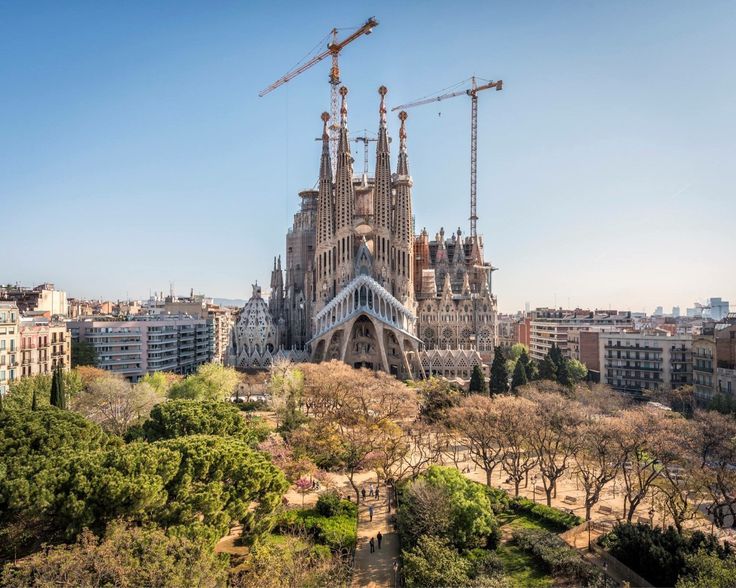
A figure on the Passion façade of La Sagrada. Wide view of the sharp, bone-like supports framing the Passion façade at La Sagrada Familia.
The Glory Façade
The third main façade of the Sagrada Família in Barcelona, Spain is known as the Glory Façade. It is located on the southern side of the church and faces the city center. The Glory Façade was preliminarily designed by Antoni Gaudí via sketches, and is intended to represent the glorious eternal life after the death of Jesus.
According to the Sagrada Familia site,
“The facade will have tall columns dedicated to the seven holy gifts and will depict the seven deadly gifts at the bottom and the seven heavenly virtues at the top. The facade will have five doors corresponding to the five naves of the temple, with the central one having a triple entrance, making a total of seven entrances representing the seven sacraments of Baptism, Confirmation, Eucharist, Penance, Holy orders, Marriage, and Anointing of the sick.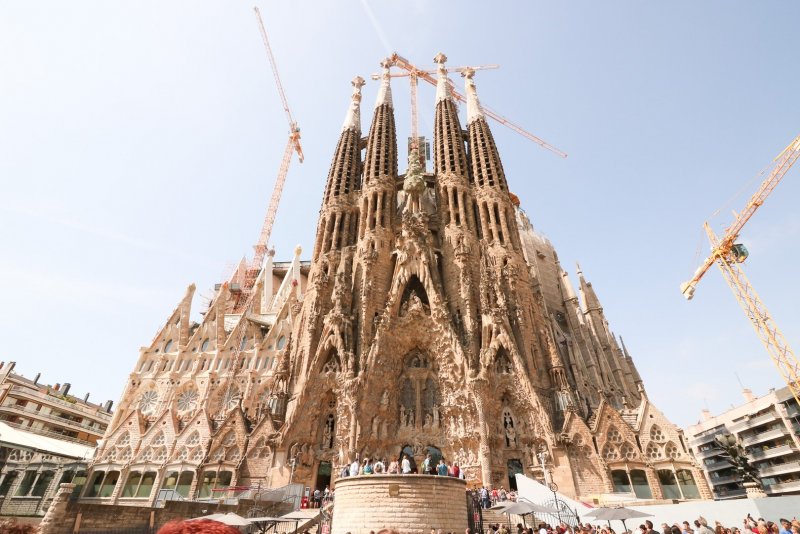
From the Glory Façade you can also see four towers, each representing one of the four evangelists: Matthew, Mark, Luke, and John. It also has three porticos, each representing a different aspect of the glory of God: the Portico of the Apostles, the Portico of the Prophets, and the Portico of the Martyrs. The Portico of the Apostles is decorated with sculptures of the twelve apostles, while the Portico of the Prophets depicts Old Testament prophets. The Portico of the Martyrs is adorned with sculptures that depict Christian martyrs.
This is the newest facade, and construction of the facade began in 2002 and is not yet completed, but will serve as the church’s main entrance upon completion of the church.
Touring Inside La Sagrada Familia
As one would suspect from a building with this much detail planned into every aspect, the inside is exquisite, too.
The ceiling is so extraordinary that I very nearly caved into my desire to lay flat-out on the floor and get lost in the flowing tiers and spires (that would have definitely broken social protocol though).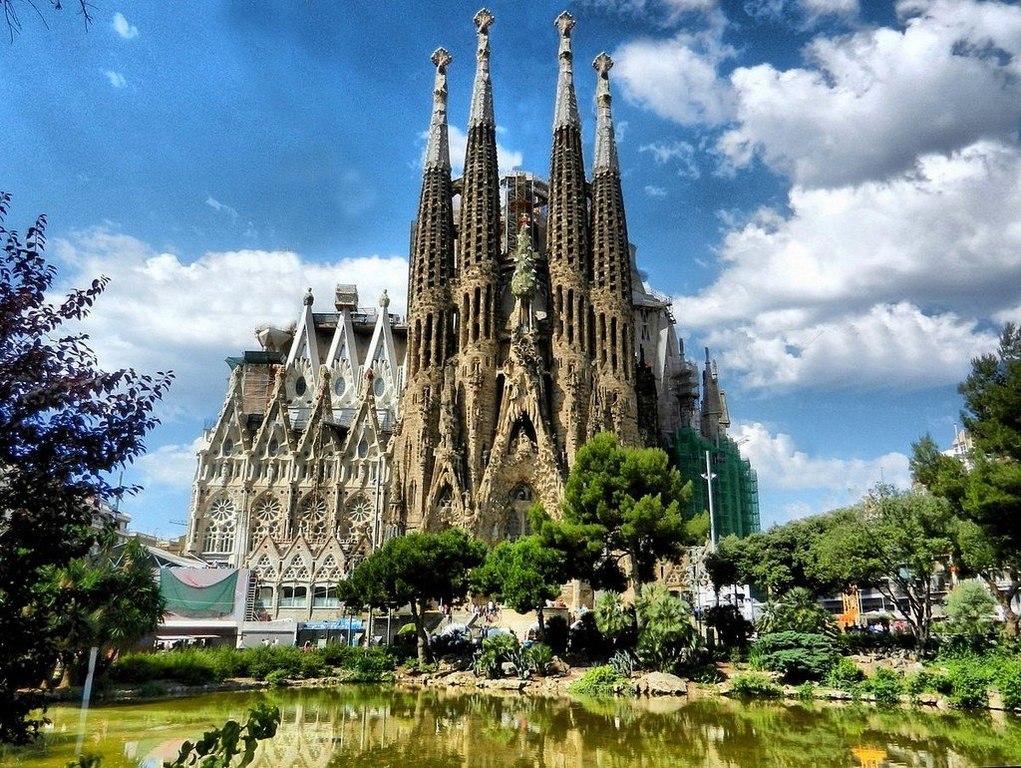
Views looking straight up at the ceiling of La Sagrada Familia. The support columns branch out like trees, and when coupled with the stunning stained glass and other architectural flourishes, it truly feels like Gaudí managed to bring a forest into the cathedral. La Sagrada Familia is still under construction, so it’s fascinating to see things like the stained glass windows slowly begin to fill the church walls. Inside the church, looking toward the altar.
I spent the better part of my afternoon wandering the huge church, then below in the museum looking at the plans and miniature projections of the completed project. Thanks to the magic of computers and technology (which Gaudí did not factor into his two-century timeline for completion of his masterpiece), La Sagrada Familia could be done as early as 2026.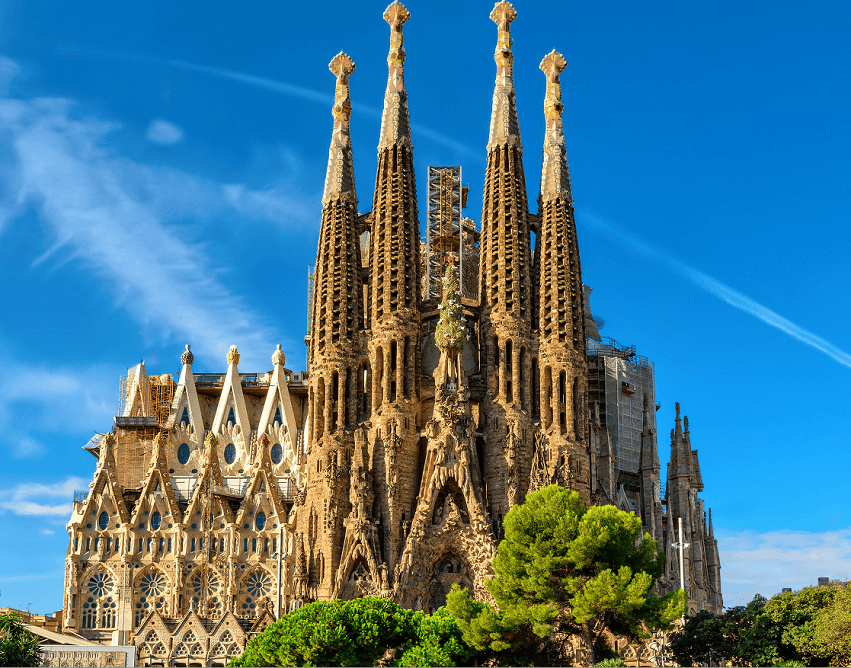
When I emerged from the church, I soaked in the late afternoon sunshine. The welcome change in the weather matched my lifted spirits. I felt lighter after immersing myself so completely in learning about how one man’s creativity and religious fervor could compel him to funnel his passion so narrowly into a project that would affect millions of people and span several centuries.
It blew my mind.
The scope of his vision, the faith that people would continue donating to finish the church, the drive to work with such focus on a single project—I left both awed and envious. And I left living in a wider world, a world with more possibilities for those with the drive to follow a passion through to the end. I bid adiós to the church, but really more of a “see you in 20 years,” when I’ll be back to see Gaudí’s completed magnum opus.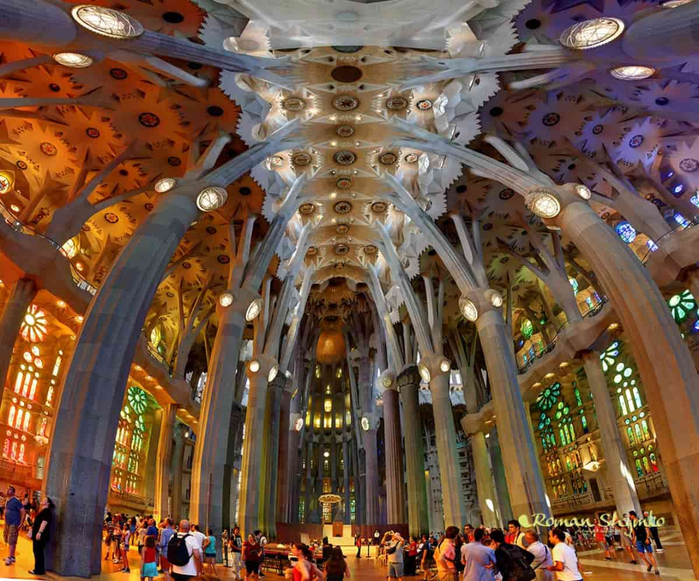
On subsequent trips, since I now live in Barcelona, I’ve enjoyed gorgeous blue skies at La Sagrada Familia.
Tips for Visiting La Sagrada Familia
How to Book Your Visit
Yes, the Sagrada Familia is open for visits, with additional post-COVID precautions in place to avoid overcrowding. Book ahead through the official site and screenshot your ticket on your phone. This was the best advice and help I received by far. You choose an hour-long time window to visit the church and you bypass the huge queue with very quick access. The towers were not open on my first visit because of the rain, so I was only able to do that on my return in 2017 (and again when family visited in 2019). You can and must pre-book this as well—the tower view time slots go very quickly, so book at least two days ahead of time if that is your plan. I cannot stress pre-booking enough—even in off-peak times tickets sell out days in advance. And in the summer, standing in the July and August heat for hours is truly brutal.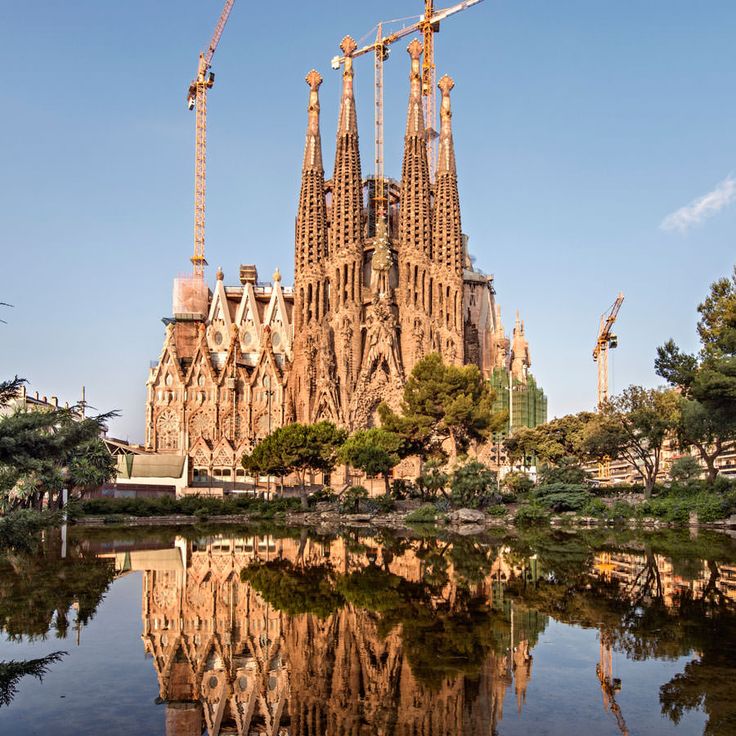
How Much Does La Sagrada Cost?
There are several options you can pay for when buying a ticket. I paid to enter the church and the museum, as well as an audioguide (so worth the price in my opinion—I’ve done the audio tour three times and have never regretted it). On my return visit in 2017, my niece and I booked a ticket up the Façade (Also worth it if you like panoramic views, or are an architecture fan! The views are gorgeous and it’s an inside look behind the scenes of the church’s inner workings). As of 2022, it costs €26 for a basic ticket to enter the Basilica and have an audioguide and €30 for that plus a live guide. It’s upwards of €30 to go up a tower and have an audioguide (if you book a tower view ticket, do not be late for your appointment time).
What to Wear to La Sagrada Familia
It surprises some tourists to discover that there is, in fact a dress code to enter the Basilica, and yes, it is enforced! Per the official site, visitors must dress appropriately, following these restrictions:
- No see-through clothing.
- Tops must cover the shoulders.
- Trousers and skirts must come down to at least mid-thigh.
- Visitors may not enter in swimwear.
- Visitors will not be allowed to enter wearing special clothing to celebrate any sort of festivities, nor with any decorations designed to distract or draw attention for artistic, religious, promotional or any other purposes.
I wore a shirt with a very low-cut back once and they were not pleased. I had to pin the back pieces together. So, be warned that even in the summer tank tops and short shorts will not cut it to visit the church.
Getting to La Sagrada Familia
It’s a long walk from the downtown Gothic quarter of Barcelona, so plan your trip well.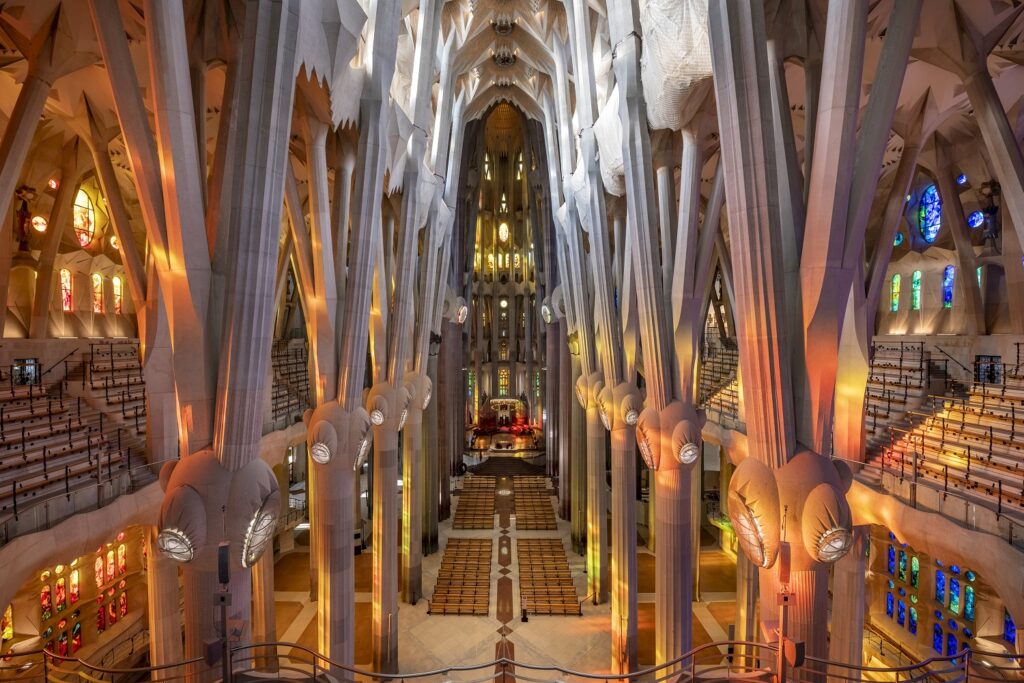
When Should You Visit?
The first time I visited, on recommendation from my hostel (they helped me buy and print my ticket) I took a 4 pm time slot, which was fairly calm (though there was a queue for those without pre-purchased tickets).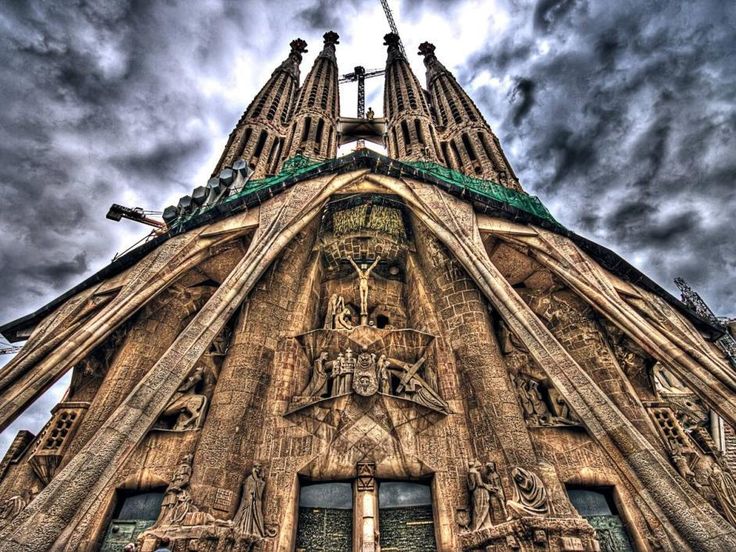
Learn the Necessary Background to Enjoy
Every place is more interesting with back story; read a Guadí biography before you visit for a deeper perspective on this world-famous architect. This beautiful photographic collection showcases his work. And if you’re staying in Spain for a bit, consider the Spanish Lonely Planet as your guide, it was my go-to on both visits.
Essential Travel Planning Resources:
Booking.com: Essentially the only hotel booking site that I use in the region as it has the widest and most affordable selection in Southeast Asia.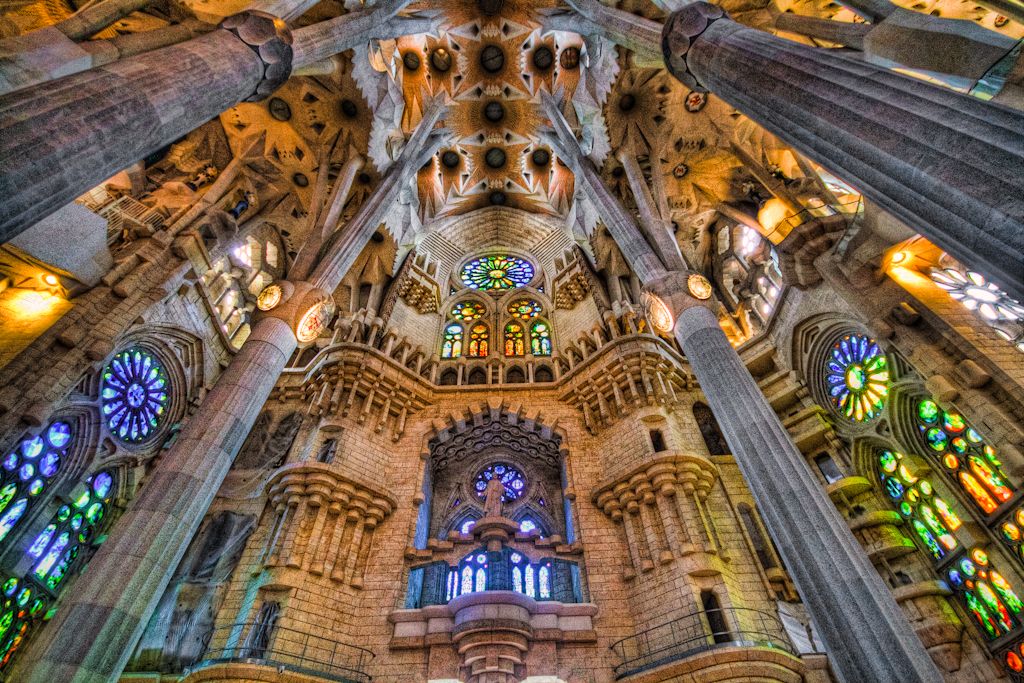
Rome2Rio: Super handy to assess the full range of transport options between two cities—shows everything from flights to trains, buses, minibuses, and more.
Expedia: Best site, hands down, for low-cost flights in the region.
IMG Global: A travel insurance option I’ve used for well over a decade and recommend for many other travelers.
A Complete Guide for Visiting the Sagrada Família in Barcelona – Blog
One of the most visited places in Barcelona is the ornate Roman Catholic basilica la Sagrada Família aka the Basilica of the Holy Family. And rightfully so. This still unfinished but incredible church was designed by the famous Catalan architect Antoni Gaudí and is both a representation of his imagination and a reflection of his thoughts on faith and religion.
In this post, I’ll share some insights into the architecture of this building, some interesting facts about the basilica, and helpful pointers on how to prepare for your visit to the beautiful Sagrada Família.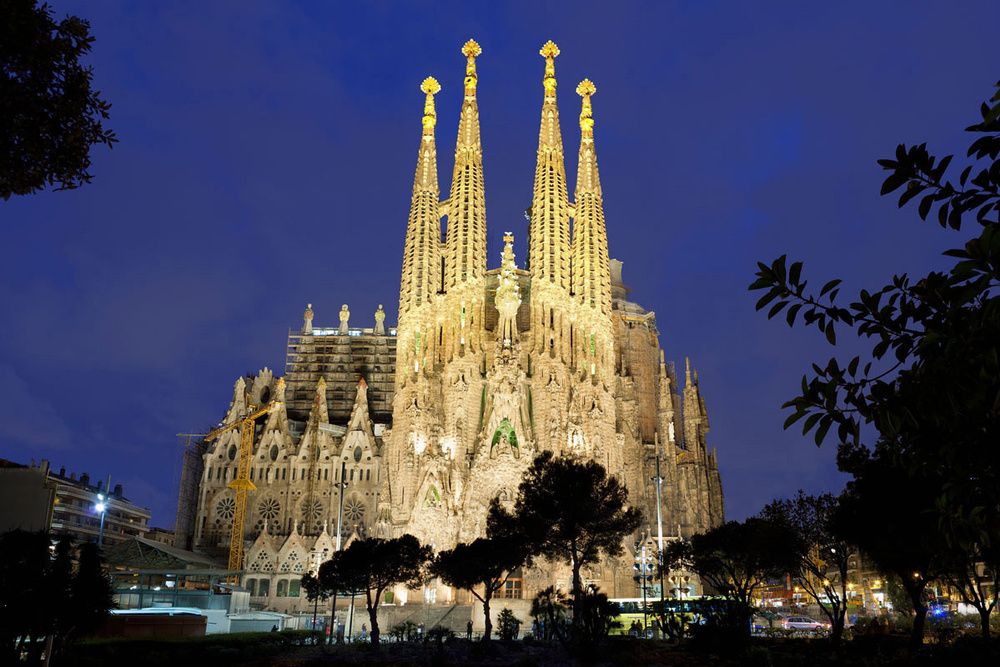
A work in progress
It might surprise you to find cranes and scaffolding surrounding the church. Although construction on Gaudí’s masterpiece began in 1882, only a quarter of the work had been completed at the time of his death.
Since then, there have been nine architects who have taken on the project only to walk away due to its complexity. However, even with this turnover, the project has remained faithful to Gaudí’s original plans and will be completed. The original completion date was set for 2026 to mark the 100th anniversary of the architect’s death, but construction was delayed due to the pandemic, and a new completion date hasn’t been set.
Did you know? Originally, the project was financed by private patrons, but these days, most of the funding comes from the entrance fees. So if you visit, your ticket will contribute to the building of this masterpiece!
Modernist architecture
No one can deny the grandiose feel of this basilica.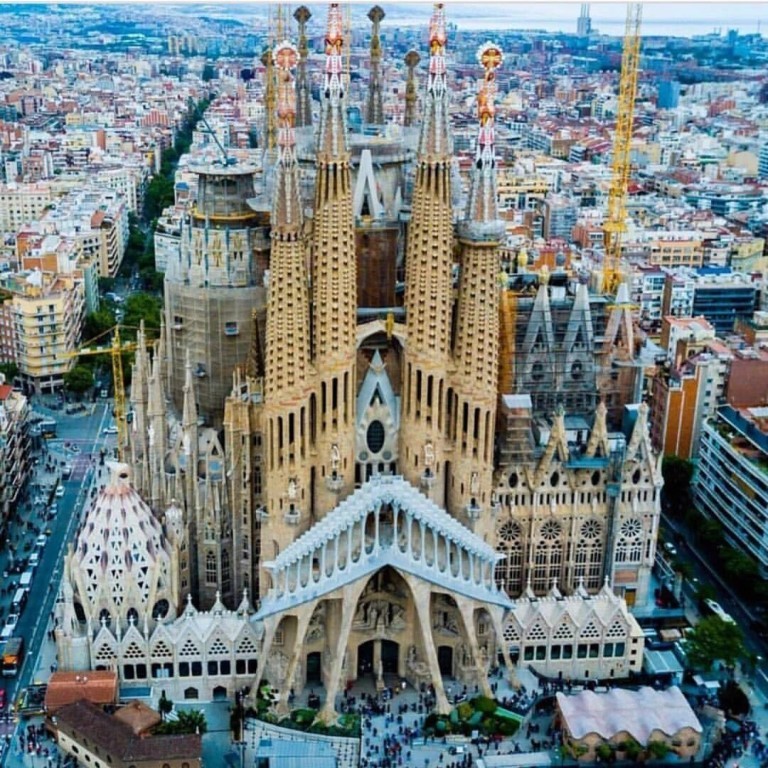
The Sagrada Família’s many symbols
There are three intricately designed façades to the Basilica, and each has detailed motifs that reflect a moment in Christ’s life.
- the Nativity (his birth)
- the Passion (the crucifixion)
- the Glory (in heaven)
The Nativity façade has animal and human figures while the Passion façade is much more dramatic with pillars that appear to have skeletal sculptures. The Glory façade is one of the most striking, featuring scenes of the Last Judgment, including both heaven and hell. It also grants access to the Basilica’s central nave.
There are 18 towers in total. The tallest and most majestic symbolizes Jesus Christ and, once completed, will measure 566 feet.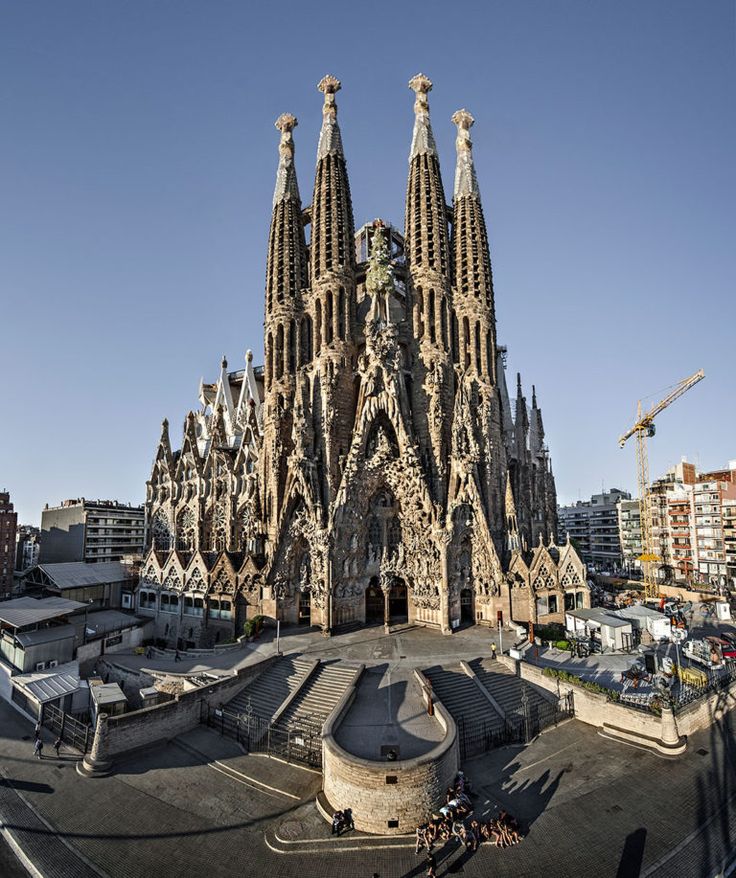
Interior of the Sagrada Família
For the interior of the church, Gaudí kept with the nature theme by avoiding straight lines. Instead, he created an environment with winding tree-like columns and a symphony of colors.
Towering stained glass windows dominate the interior of the Sagrada Família with ever-changing shades depending on the time of day and even the weather. A sunny day will produce dynamic explosions of bright color while a cloudy day will reflect soft and soothing hues.
Fun facts about the Sagrada Família
Here are seven fascinating facts about the Sagrada Família you might not know. Of course, you’ll learn many more on our guided tour of Barcelona’s best architecture.
- The Sagrada Família is a UNESCO World Heritage Site, even though it still hasn’t been completed.
- To pay tribute to basilica workers, the builders’ faces were used as models and their images can be found sculpted in stone of the Portal of Mercy façade.
- Gaudí wasn’t the original architect. Construction started under Francisco de Paula del Villar, who resigned in 1883, allowing Gaudí to take over as chief architect.
- The Sagrada Família is the most visited place in Spain, boasting almost 3 million visitors a year.
- The Sagrada Família has been built entirely with donations and has not been backed by the church or the government. Construction today is still funded with entrance fees.
- There is a mysterious square with mixed numbers on the Passion façade. No one knows what the numbers mean, but when all are added up in any direction, they equal 33. Experts believe this square is tied to the age of Christ’s death.
- Gaudí is buried here. He died on June 10, 1926, after being hit by a tram on his way to visit the Sagrada Família. His tomb can be found in the El Carmen Virgin chapel.
How to plan your visit to the Sagrada Família
I highly recommend taking public transit here instead of a car so you don’t have to deal with parking.
Here are the public transportation networks that serve the Sagrada Família.
- Metro: L2 or L5
- Bus: 19, 33, 34, D50, h20 or B24
La Sagrada Família is open Monday through Friday from 9 a.m. to 6 p.m.
COVID-19 note: Opening dates and times could change depending on the COVID-19 situation, so be sure to check before your visit. If you’re visiting with our tour, we’ll take care of this for you. The Sagrada Família follows the COVID-19 rules established by the Ministry of Health. Currently, masks are required to enter. For the most updated information, check here.
Where to buy tickets for the Sagrada Família
You can buy tickets on the official site or on the app and then present the voucher either in printed form or on your phone.
If you have a change of plans, you can request a refund 48 hours before your visit.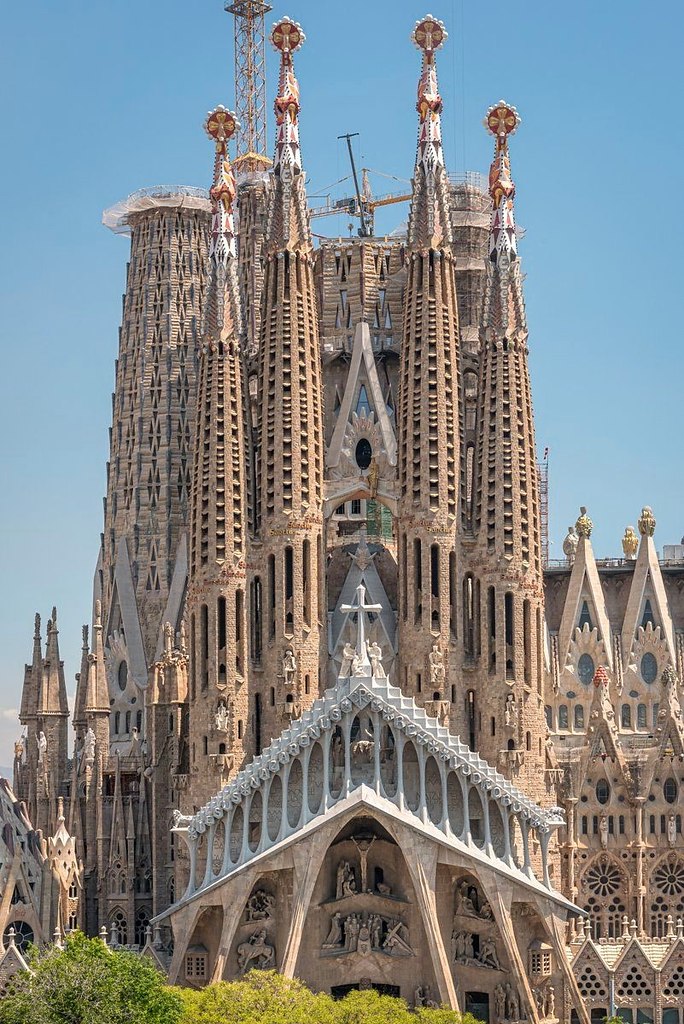
You can also join a walking tour to visit the outside of the basilica, with its multiple façades, plus other landmarks such as Casa Amatller, Casa Batlló, the Recinte Modernista Sant Pau, and more. Get tickets here to explore some of Barcelona’s best architecture, including La Sagrada Família basilica. If your plans change, you can request a refund up to 24 hours before the start of your tour.
How to dress for the Sagrada Família
Remember you are entering a place of worship. Visitors should dress appropriately, meaning tops that cover the shoulders and shorts and skirts that come down to at least mid-thigh. Hats are not allowed.
La Sagrada Família: A church like no other
The Sagrada Família is a moving and mystical place — there’s a reason it draws millions of visitors a year.
But it’s just one of many Modernist gems in Barcelona. There are more masterpieces by Gaudí and his contemporaries, several found along the lovely Passeig de Gràcia.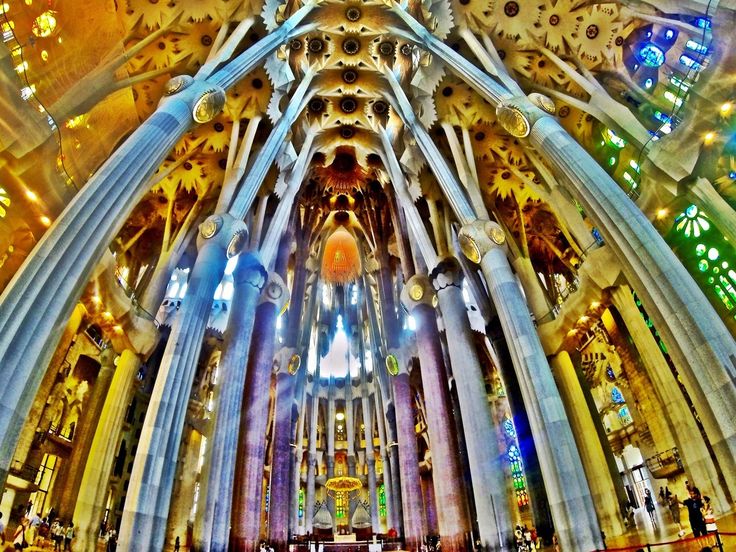
To learn more about La Sagrada Família and other architectural treasures in Barcelona, join us for our Best of Barcelona Architecture Walking Tour.
Sagrada Familia in Barcelona – the most “vertical” temple in the world
The World of Antoni Gaudí
·
August 29, 2020
Initially, as we know, Sagrada Familia in Barcelona was conceived as
neo-Gothic building. Antoni Gaudí , succeeding Francesc Villar as chief architect of the church,
radically rethought the original project. However, one of the main features of the Gothic style – vertical orientation, aspiration to height – was also preserved in Gaudí’s project. Moreover,
it was elevated by Gaudi to the absolute, which is why today there is every reason to assert: the Sagrada Familia in Barcelona is the most “vertical” temple in the world.
The very impressive height of the interiors of the Temple is what first of all amazes everyone who finds himself inside.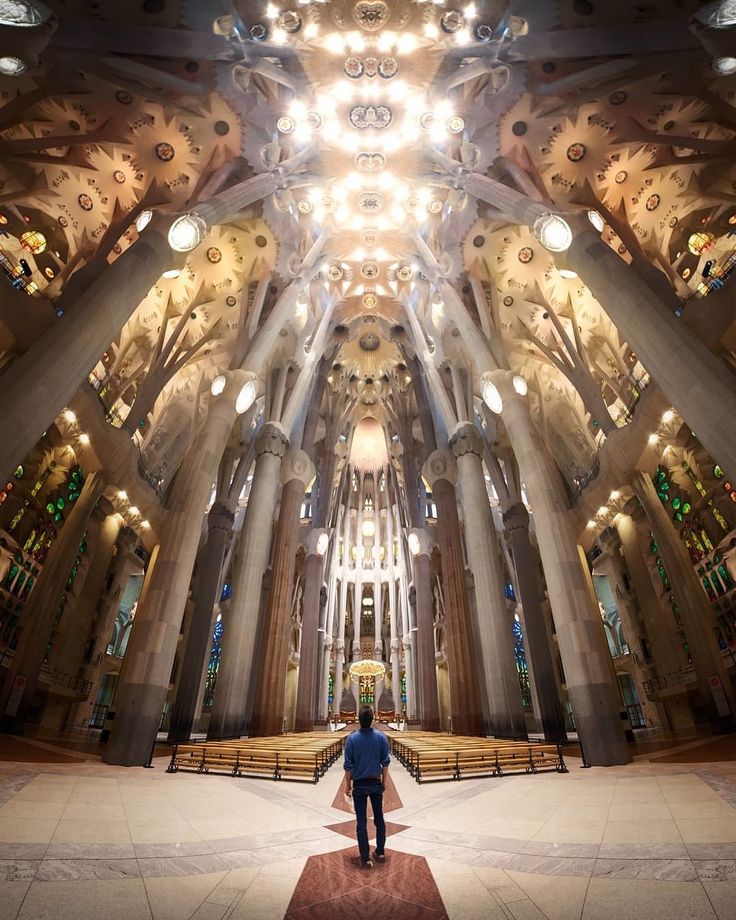
45 m. The height of the side aisles is 30 m, the central one – 45 m; the height of the vaults of the middle cross is all 60 m, and the vaults of the apse even have a record height of 75 m.
The verticality of the interiors allows you to fully experience the effect of the ascension, which is also emphasized by the presence of symborios (lanterns), of which there are as many as 6 in the temple, as opposed to traditional
churches, where, at best, only one light lantern is provided.
As Gaudi himself explained at one time, symborio is an architectural element that can, like no other, evoke in people a sense of the grandeur of the church, and, in addition, allows you to fill the temple with light in
the darkest, by definition, place of any church – the crossroads. “God is light” – and therefore the light for Gaudi has always been decisive.
In addition, the skylight naturally has an exterior that, in the case of the Sagrada Familia, most obviously serves the same purpose – to create a sense of verticality and elevation.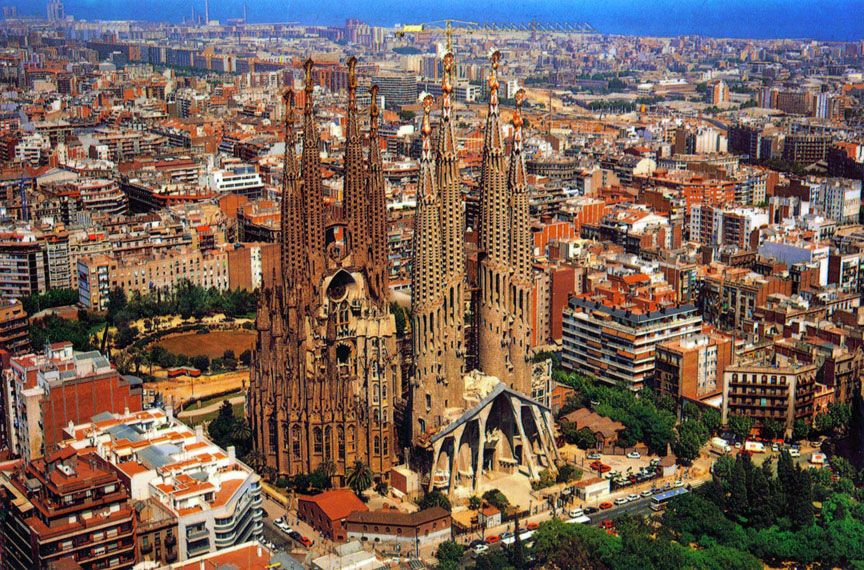
Sagrada Familia – height and proportions
After all, the light lanterns of the Sagrada Familia are nothing more than the six central towers of the church, which very soon will reach the planned height (135 m – towers
Evangelistov, 138 m – the tower of the Virgin, 172.5 m – the tower of Christ) and thus make the Sagrada Familia in Barcelona the highest Christian church in the world.
Sagrada Familia – proportions and size
According to records made in 1914-1915 Martí Matleu, secretary of the Sagrada Familia Building Council, Gaudí in sizing and before
of all, the height of the church came from the height of the hill of Montjuic, at that time the highest point of Barcelona, defining the skyline of the city.
Montjuic, in the understanding of Gaudi, is the work of God, the creator and creator of all things, and therefore the work of human hands should not exceed what was created by the Almighty. Based on this logic, the architect
initially determined the height of the church at 160 m, and then at about 170.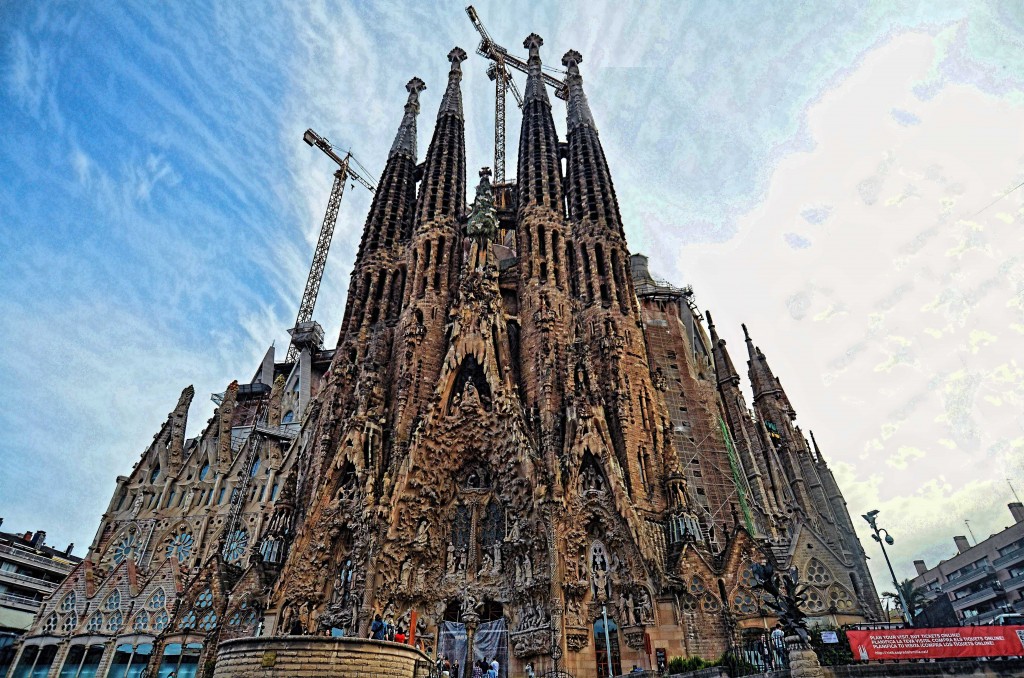
Hol Montjuic and Sagrada Familia
Much later, detailed studies of the proportions of the Temple made it possible to identify the size of the universal module, which was used by Gaudi when calculating the sizes of various architectonic elements.
church – 7.5 m. This discovery made it possible to accurately determine the height of the church, which should be exactly 172.5 m.
This figure is just 23 modules of 7.5 m each and, moreover, is in full accordance with Gaudí’s desire not to arrange “competitions” with nature – after all, the height of Montjuic is determined at about 180 m.
In turn, the height of the Montjuic hill could also become decisive in calculating the length of the Temple interiors, which is 90 m, that is, half of the height of Montjuic.
This equally applies to the height of the Towers of the Evangelists, as well as the height at which the center of the star crowning the tower of the Virgin Mary will be located. As we have already said, this height will be 135 m – then
yes, 3/4 of 180.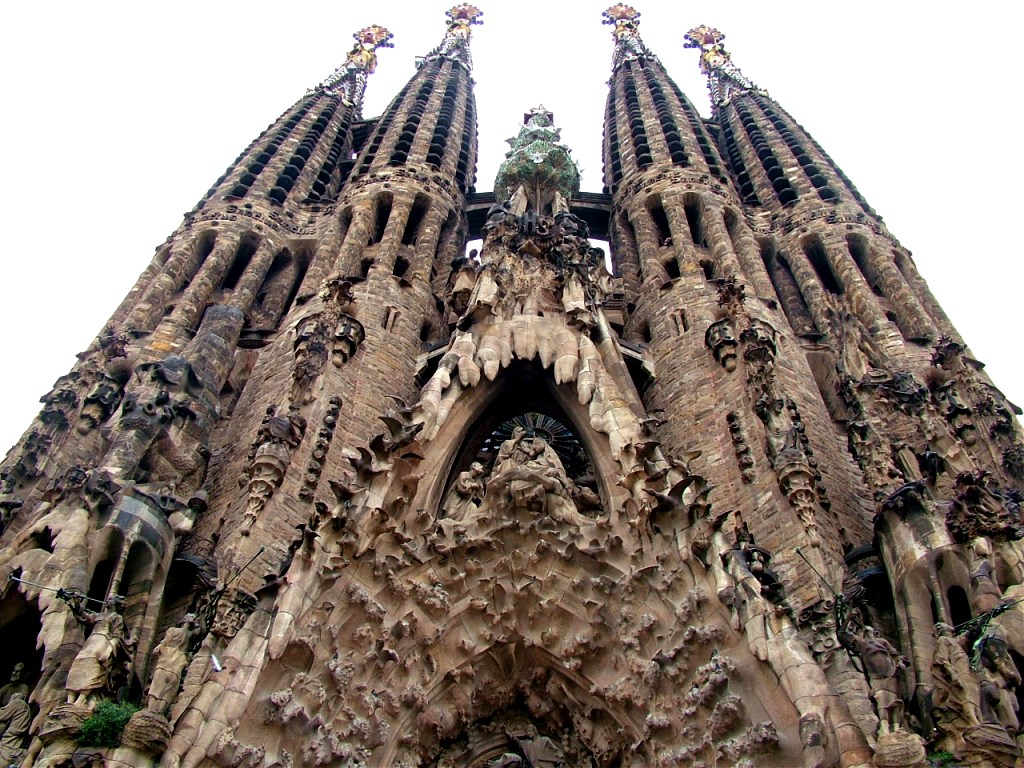
As for the dominant “verticality” of the Temple – judge for yourself: its height will almost double its length – a case in the history of the construction of large cathedrals
unprecedented!
Sagrada Familia – the tallest church in the world
ANTONIO GAUDI – EXCURSIONS
Related articles:
Sagrada Familia in
Barcelona
Saint Antonio Gaudi?
Twelve Martyrs of Sagrada
Surname
Sagrada Familia in Barcelona –
loyalty to Gaudí’s project?
REVIEWS OF OUR TOURISTS
To the “Blog” section
To section Antonio Gaudi
In the section “All excursions”
To main
tagPlaceholderTags: sagrada familia news, sagrada familia barcelona, when the sagrada familia is completed, antonio gaudí sagrada familia, unusual excursions in barcelona, gaudí sagrada familia, antonio gaudí excursions, antonio gaudí excursions, sagrada familia architect, sagrada familia height, when the sagrada familia is built
Top 10 Things to Do in Sagrada Familia (Barcelona) 2023
-
Travelers’ Choice
Things to do are ranked according to Tripadvisor, including reviews, ratings, photos and popularity.
-
Traveler Rating
Top Tripadvisor Traveler-rated Attractions
All Attractions
Categories
Attractions
Outdoor activities
Concerts and shows
Food and drink
Events
Shopping
Transport
Traveler resources
Attractions
Types02 wellness
Nightlife
Sights and cultural sites
Fun & Games
Workshops & Workshops
Nature & Parks
Traveler Rating
-
or more
-
or more
Districts
Suitable for
Cheap
Things to do on a rainy day
Suitable for couples
Suitable for children
Suitable for large groups
Honeymoon destination
Suitable for adrenaline junkies
Free entrance
Adventure
0070
Hidden Gems
travelers)
Clear all filters
0003
166,147
Points of Interest & Landmarks • Architectural landmarks
Eixample
•
Open Now
Posted by Sagrada Nothern_Angel2013 —9002 Temple of the Redeemer church in Barcelona, in the Eixample district, under construction since 1882.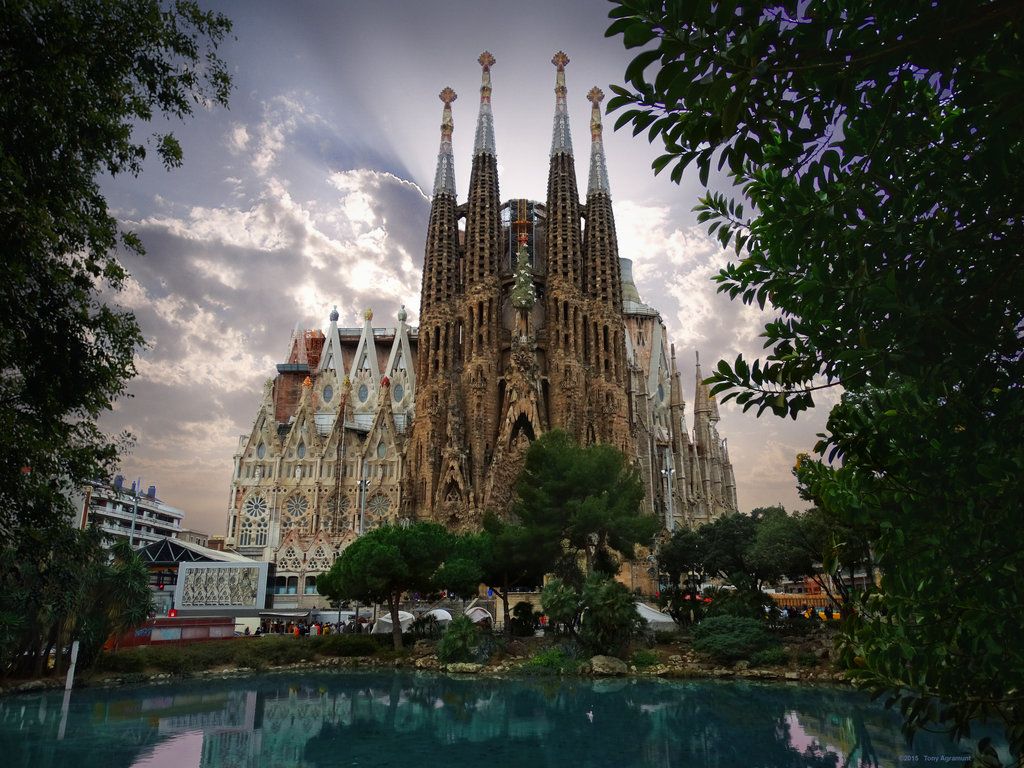
0002 Eixample
•
Open now
remarkable
Eixample
4. Elements Escape Room – Fuego – Atlantis – Cetro de Fuego
Quest Room
Eixample
•
Open Now
5. Placa de Gaudi
Points of interest and attractions • Parks
Eixample
- 0
6. Best Rent a Scooter
Equipment rental
Eixample
•
Open now
Author: Q3123TIandreyk
Rented a scooter for 3 days. Everything was wonderful. Thanks to the staff for a great scter!
8.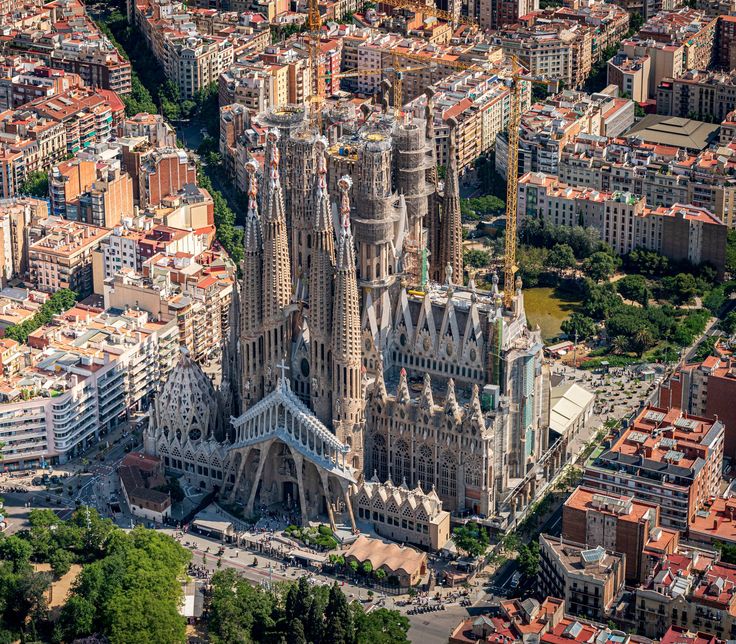
Landmarks and Landmarks • Architectural attractions
Eixample
9. Casa Planells
Architectural attractions
Eixample
10. En Diagonal Bar
Bars & Clubs • Coffee houses
15 •
Open now
11. Mural Balcones de Barcelona
Points of Interest & Landmarks
Eixample
12. Tactic Escape Rooms
Quest Room
Eixample
•
Open now
- 0
9007
Relax 13c
003
Spa
Eixample
•
Open now
14. Real Thai BCN
Spa
Eixample
•
Open now
- 5
15.
Art and pottery studios
Eixample
5
16. Edificio Myrurgia
Architectural landmarks
Eixample
17. El Buen Tiempo Persiguiendo a la Tempestad
Monuments and statues
Eixample
18. Pinxo Panxo
Points of interest and landmarks • Churches and cathedrals • Eixample
5 2 Open now
19. Tipic i Catala
Wine bars
Eixample
20. CHILL Bar Barcelona
80003
Eixample
•
Open now
Places of interest and attractions • Lessons and workshops
Eixample
•
Open now
0003
24.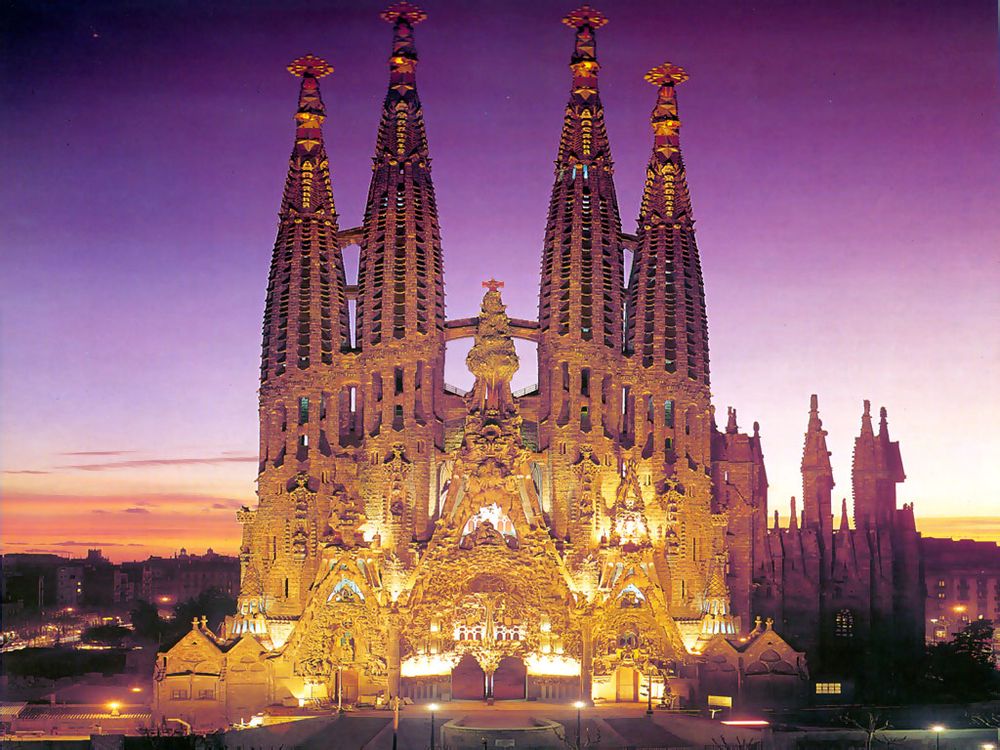
Gear Rental
Eixample
•
Open Now
Private Guide2 Barcelona.
City tours • Walking tours
Eixample
4
27. Pivobar
Bars and clubs
Eixample
28. Bodega del Poblet – Don Pepe
0064
29. Moubikes
Bicycle trails • Equipment rental
Eixample
900 20 open now 3 • 0 90 115 03
30. Arte Contigo Barcelona
Artistic studios and potteries
Eixample
Showing results 1-30 of 98
-
Lilia Pozdnova
Tel Aviv, Israel0003
Delight! Space!
Sagrada Familia in Barcelona is one of the most amazing buildings I have ever seen! I was amazed by the scale and beauty of this place, and it seems to me that it is a real miracle of architecture.
The entrance to the temple is decorated with majestic facades that describe scenes from the Bible, and inside the viewer is in for a stunning beauty. The architect Antonio Gaudí has created amazing forms, decorated with granite and mosaics, and every element of the building seems to be thought out to the smallest detail.
One of the most impressive moments was climbing one of the towers, which offers a breathtaking view of Barcelona. I was blown away by the height and space of this place and I feel like Sagrada Familia is a must visit place in Barcelona.
Overall, I was very impressed with Sagrada Familia and I think it’s one of the most amazing places to visit in Europe. If you haven’t been here yet, be sure to visit this place!
Tickets must be purchased online and in advance! Just come to the building, buy tickets and go inside, if you are an independent traveler, it will not work!
Review for Sagrada Familia
Published April 21, 2023
This review represents the subjective opinion of a member of the Tripadvisor community and is not the official position of Tripadvisor LLC.
Tripadvisor checks reviews.
-
Ludmila K
Moscow, Russia365 publications
Excellent service
Thank you Tripadviser for helping us find such a great company.
For trips outside of Barcelona, I advise only them.
And it was very pleasant to get to the airport with them.Review for: Limo Service Press i Car BCN
Published February 29, 2016
This review reflects the subjective opinion of a member of the Tripadvisor community and is not the official position of Tripadvisor LLC. Tripadvisor checks reviews.
-
p_nn_nn
Nizhny Novgorod, Russia1,087 publications
One of the shooting points
We left the basilica – sit on the bench, arrived earlier than your ticket time – sit on the bench. Across the road – bakeries and coffee shops with takeaway food, you can have a bite while contemplating.
Review for: Placa de la Sagrada Familia
Published January 19, 2020
This review represents the subjective opinion of a member of the Tripadvisor community and is not the official position of Tripadvisor LLC.
Tripadvisor checks reviews.
-
Oleg Pokrovskiy
Zhukovka, Russia37,662 publications cheat tourists for money, so watch out and in no case communicate with these outcasts and do not sign anything. Several cafes in the park, many trees and ducks swim in the pond. Complete idyll
Review for: Placa de Gaudi
Published September 2, 2018
This review represents the subjective opinion of a member of the Tripadvisor community and is not the official position of Tripadvisor LLC. Tripadvisor checks reviews.
-
Andrey K
1 publication
Excellent
Rented a scooter for 3 days. Everything was wonderful. Thanks to the staff for a great scter!
Review for: Best Rent a Scooter
Posted October 24, 2022
This review reflects the subjective opinion of a member of the Tripadvisor community and not the official position of Tripadvisor LLC.
Tripadvisor checks reviews.
-
Anna O
Moscow, Russia1,327 publications
excellent selection of products
The market was built recently – 1993, it has no historical or architectural charm, but it is very functional and offers an excellent selection of fresh products at affordable prices.
Review for: Mercat Sagrada Familia
Published December 7, 2015
This review represents the subjective opinion of a member of the Tripadvisor community and is not the official position of Tripadvisor LLC. Tripadvisor checks reviews.
-
Svetlana P
Moscow, Russia151 publications
Vintage festival! 🙂
We got here for a vintage festival, there was beer, various street food, a vintage flea market, and a DJ! It was fun and tasty, you could see part of the plant, but we really liked the party itself! :)))
There is wi-fi!Review for: Antigua Fabrica Estrella Damm
Published May 6, 2017
This review represents the subjective opinion of a member of the Tripadvisor community and is not the official position of Tripadvisor LLC.

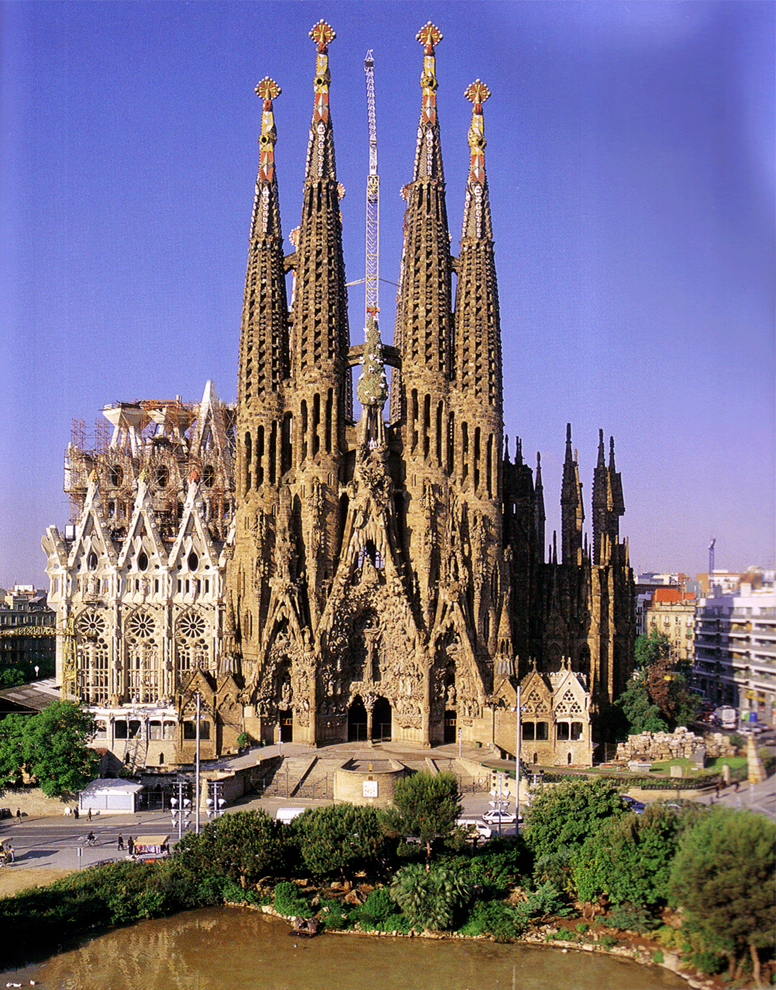
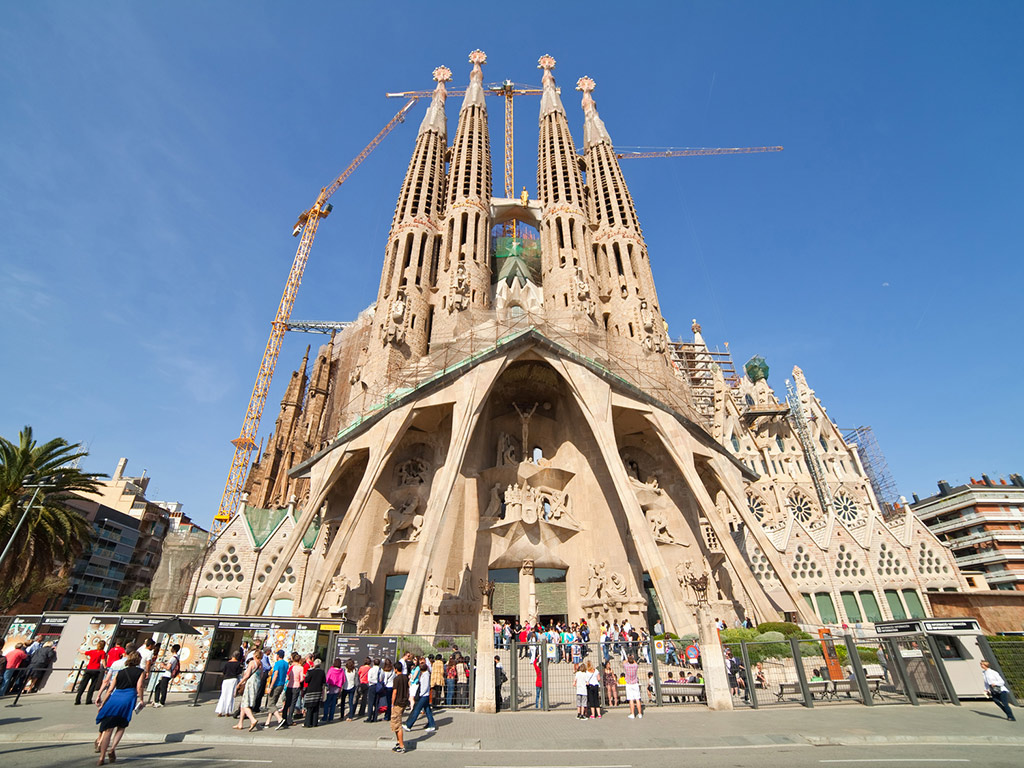
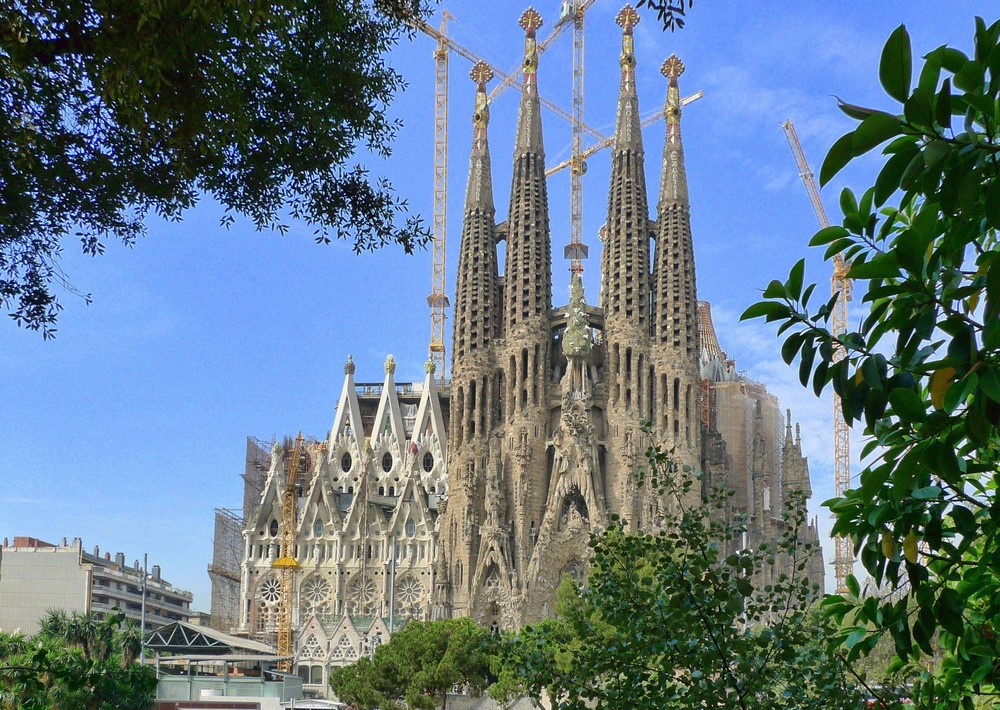
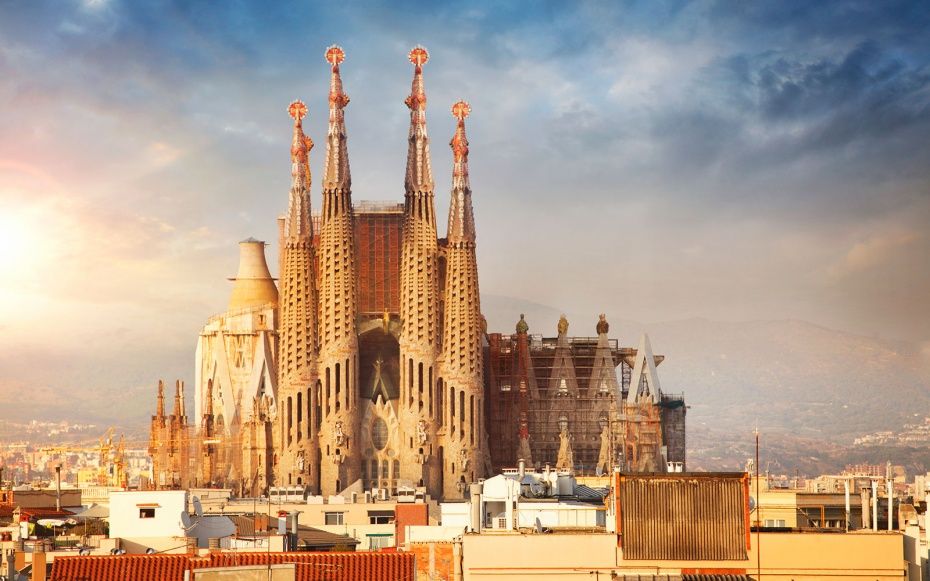
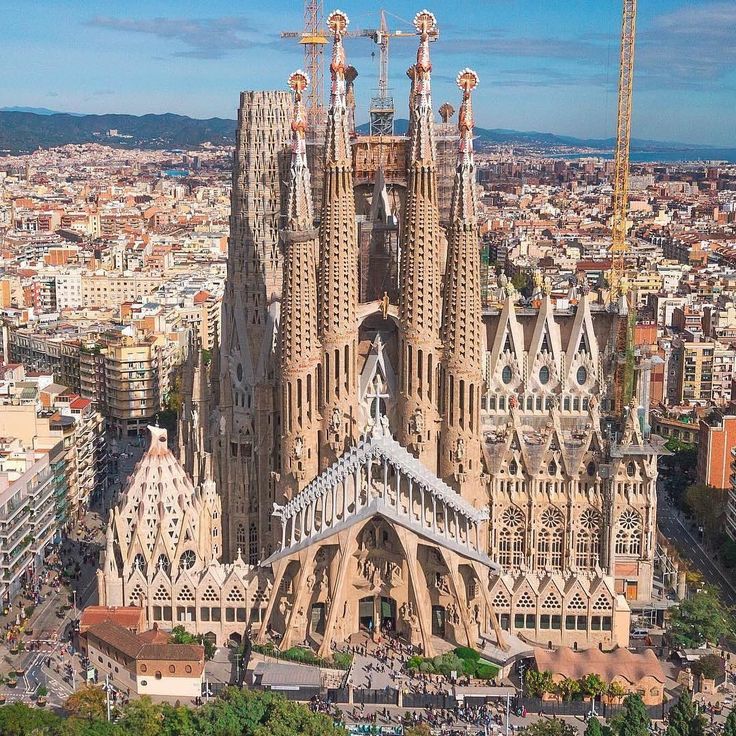 Tripadvisor checks reviews.
Tripadvisor checks reviews. 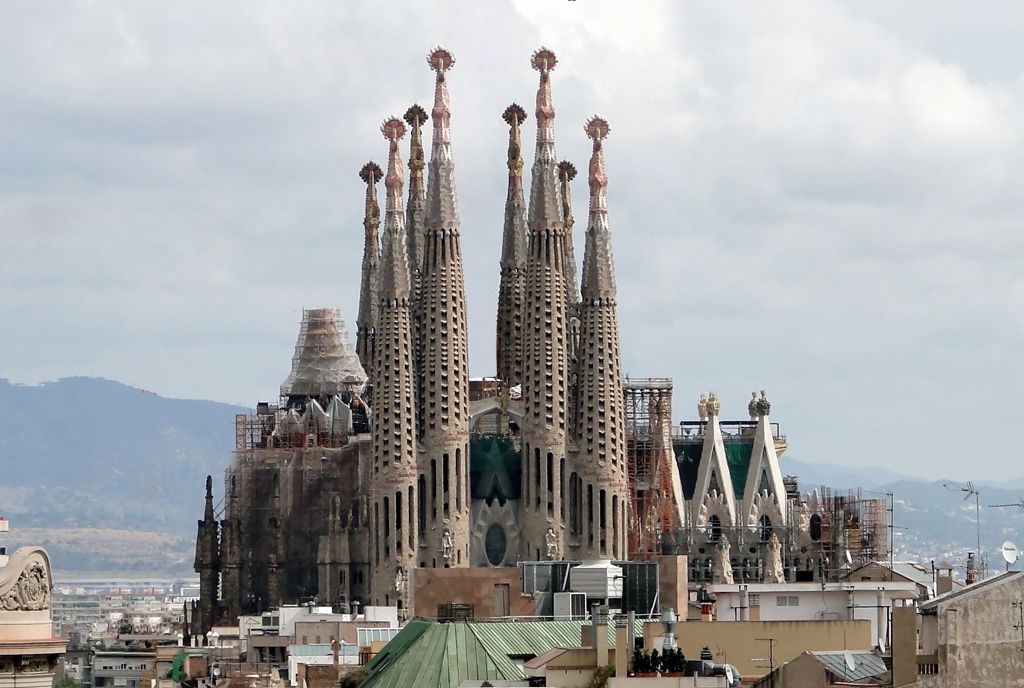 Tripadvisor checks reviews.
Tripadvisor checks reviews.  Tripadvisor checks reviews.
Tripadvisor checks reviews. 